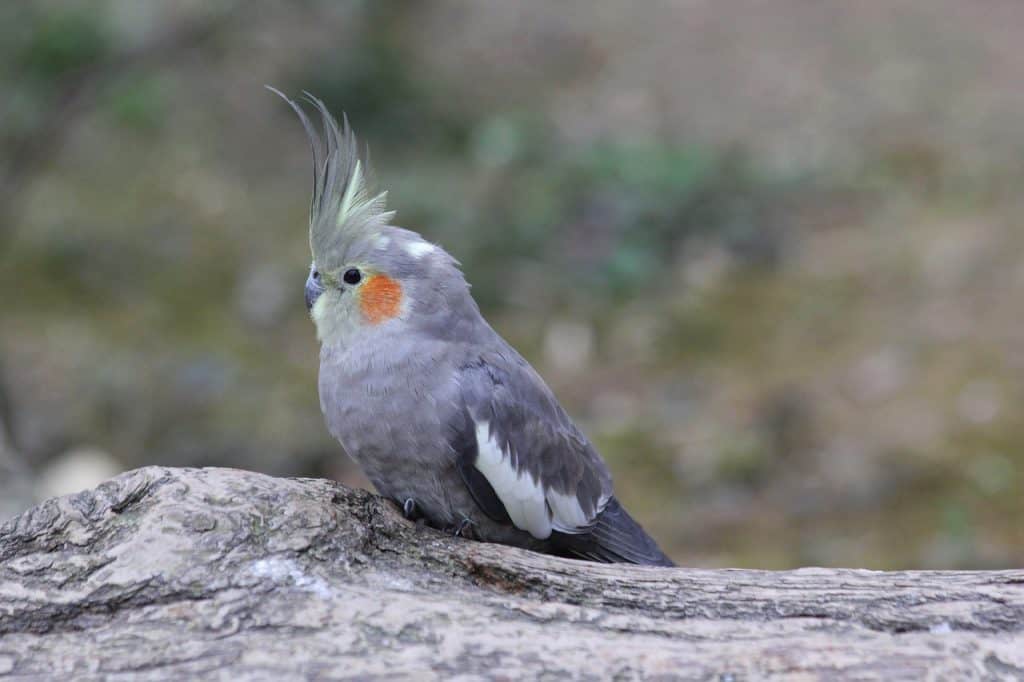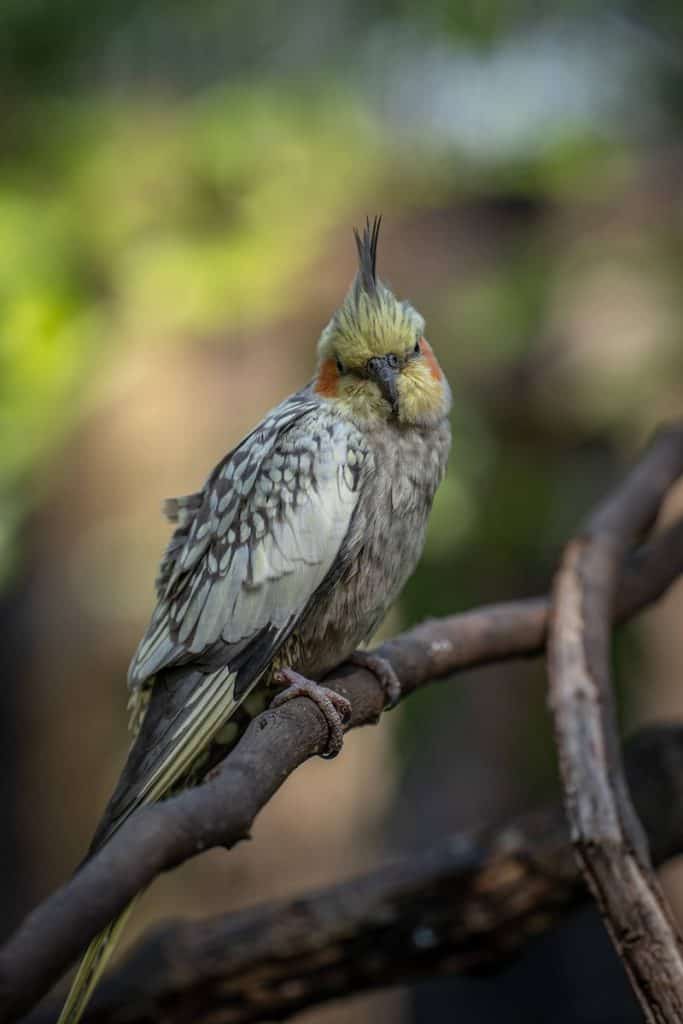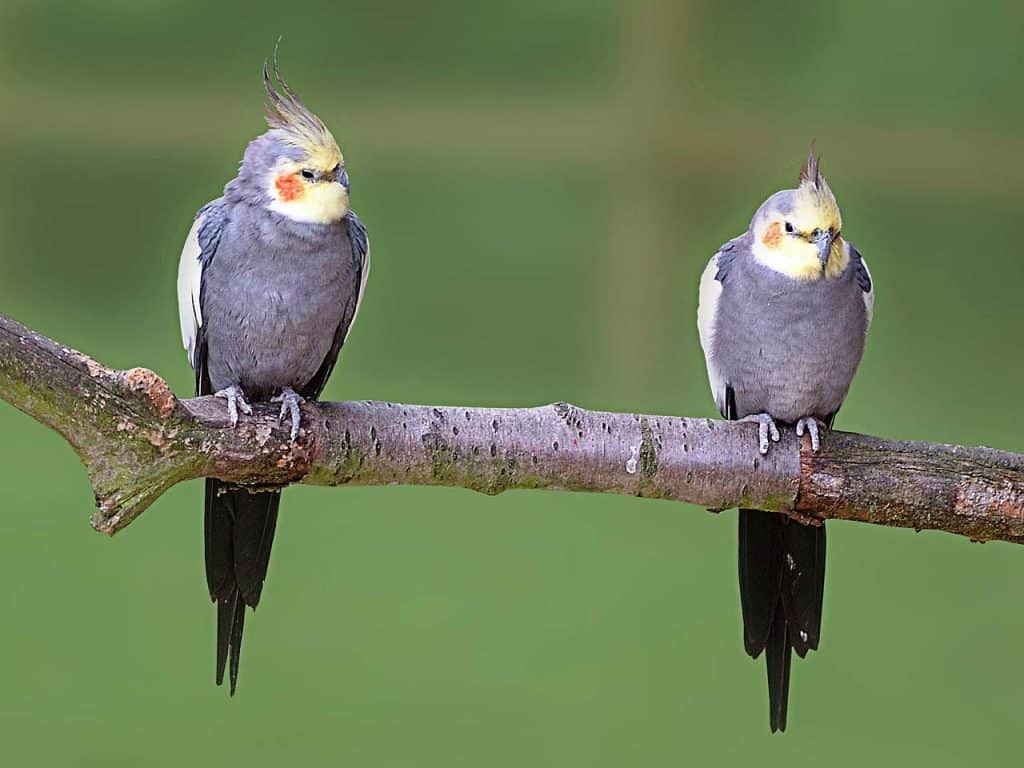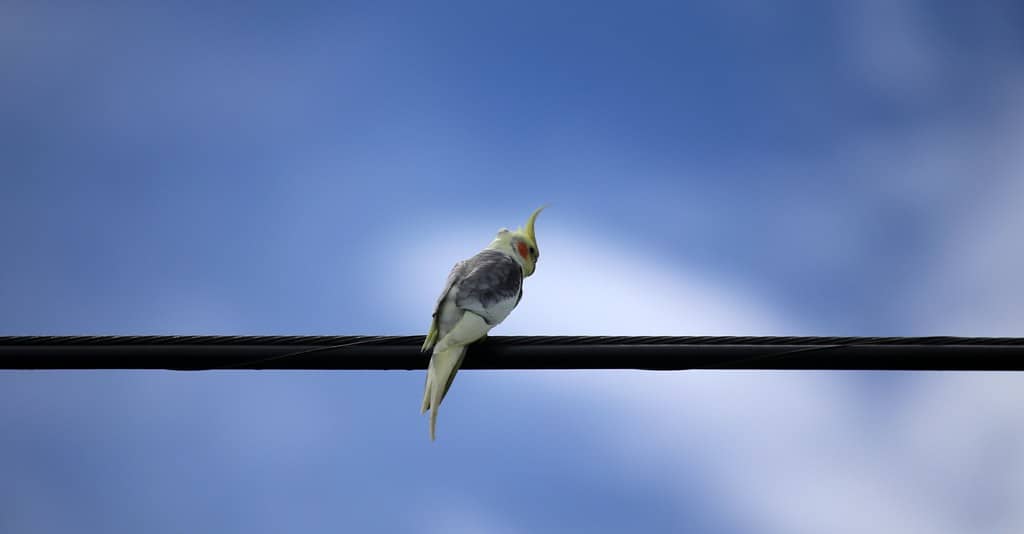It’s a heart-stopping moment. Suddenly, your pet cockatiel has flown from its cage and disappeared. As a bird owner, there’s a unique kind of panic when your pet bird wisely uses that moment you left the bird’s cage door open. But don’t feel alone or lose hope; it’s more common than you think, and there are ways to handle the situation. In this piece, we’ll guide you on how to find a cockatiel that flew away.
Even brilliantly colored birds like cockatiels can be challenging to spot when they fly away, especially when they settle in nearby trees. It’s also important to remember that when a bird flies away, it doesn’t mean it’s gone forever or that it’s hopelessly lost. Domesticated or captive birds are usually less prepared for the great outdoors than their wild counterparts. But be rest assured, your escaped cockatiel can survive in the wild.
In the first few hours after the bird flew, your lost bird might not have gone far. Cockatiels are not long-distance fliers; tiredness will overtake their initial excitement. Your pet might even be closer than you think. So, your immediate prompt response could make the difference between a quick return and a prolonged search for your missing bird. Armed with the right techniques to trace your lost friend, you can significantly increase your chances of being reunited.
Understanding Why Cockatiels Fly Away

It’s easy to feel a sense of panic when your pet bird, particularly your beloved cockatiel, flies away. But to find your lost bird, understanding why cockatiels fly away is a critical first step.
A cockatiel’s fly instinct is essentially one of self-preservation. In the wild, birds fly away from perceived threats, and even domesticated pet birds could retain these instincts. A cockatiel flew away could therefore simply be because it got spooked by something unfamiliar.
Fear isn’t the only reason though. Just like most birds, cockatiels have a strong desire for freedom. Despite being captive birds, they might manage to escape if the bird’s cage door is left open. A bird flies to explore its surroundings, satisfy its curiosity, and enjoy its natural instinct to fly.
Cockatiels are also naturally drawn to nest in tall trees. So, if your bird’s cage is near a window with a view of trees, the temptation to fly may be irresistible.
Moreover, the bird’s wings play a pivotal role here. Clipped wings can deter escape attempts. However, if your bird’s wings weren’t clipped or have regrown feathers, the likelihood of your cockatiel flying off increases. While most pet bird owners prefer to keep their bird’s wings clipped, some choose to let their birds fly freely around the house. But remember, a bird flew can be difficult to retrieve, especially if it escapes outdoors.
It’s crucial to have some control measures in place. A common practice is having a double-door boundary to the bird’s primary living or flying space that prevents an escape to the outdoors. Install bird nets for added protection.
Lastly, sometimes a bird flies away in search of a mate. This is particularly common during the breeding season when birds’ hormones go into overdrive.
Quick Actions: How to Find a Cockatiel That Flew Away

Discovering that your beloved cockatiel flew away can be quite alarming. When pet birds, like cockatiels, accidentally escape, it’s crucial to act swiftly and wisely. Here’s what you should do when your little bird decides to explore the world beyond its cage.
First and foremost, it’s paramount that you don’t lose hope or give up on your lost bird too soon. Most missing birds, even those as small and delicate as a cockatiel, are found within the first few hours to days after their escape. It’s important to stay determined and act diligently.
Start by searching nearby trees and tall perches, where most escaped birds tend to go. Cockatiels, like many birds, have a fondness for high places due to their bird’s eye view. They might even be hiding in nearby poles or light poles. Thus, an immediate, thorough search of these areas can often lead to your lost cockatiel.
The next step is to inform your neighbors, local bird clubs, and pet bird owners around the area about your pet cockatiel that has flown away. Often, other bird enthusiasts can offer significant help in locating lost birds. Designate familiar landmarks to allow people to recognize the exact location where your bird flew from.
Also, reach out to local vets, pet stores, and local animal shelters to report your missing bird. Many escaped cockatiels end up in found centers, veterinary offices, or even are discovered by a few people who know how and where to return them. Including a recent photo and distinctive characteristics of your bird can be a game changer in this process.
It’s also worth reaching out to the wild, literally. Since birds, unlike most captive animals, respond emphatically to familiar sounds, try playing your bird’s favorite song or even their fellow species call. It’s believed that the familiar sounds could attract your bird from even the tallest of trees, making the bird enter a sense of recognition and trust.
Lastly, leave your bird’s cage outside with the cage door open. Add in some familiar food, or even your other pet birds if it’s safe, which could lure your cockatiel back. They might see the cage as a familiar landmark and fly back.
Remember, the goal is not to panic but to respond immediately. It might be distressing when your bird flies away, but with these steps, you’re more likely to find your escaped cockatiel and bring them back to safety.
- SOLID AND DURABLE MATERIAL - Bird cage is made from thick, wrought iron. The sturdy metal frame construction is coated with spray powder paint that improves wear and corrosion resistance. The product does not contain any sharp edges that might hurt birds.
- SECURE AND FREE ACCESSORIES - The cage comes with two large front doors for birds to fly in & out. The long sliding bar latched firmly secures doors and keeps unattended pets from escaping. And with 3 polished wooden perches,4 plastic feeders.
- SPACIOUS INTERIOR LIVING ROOM & FLIGHT ROOM - This cage is spacious enough for birds to fly comfortably and can be beautifully decorated. Plenty of room to accommodate multiple small birds flying, exercising, or playing simultaneously. You are free to add more perches or toys as youd like.
- EASY CLEANING - It features a clean, hygienic slide-out tray that can be smoothly pulled out for cleaning & feeding. Besides, the bottom grille prevents pets from stepping on their own droppings. Beneath the grids, there is a clean, hygienic slide-out tray that can be smoothly pulled out and wiped down.
- HIGHLY MOBILE - Bird cage with stand that sits on four heavy duty rolling casters allows convenient movement. Easily relocate your pets and enjoy the outdoor weather.
Tips for Preventing Future Escapes
After experiencing the distress of a lost cockatiel, you’re likely wondering how to prevent future escapes. No bird owner wants to be left scouring nearby trees and local bird clubs, afraid their beloved pet bird won’t survive in the wild. Yet, there are specific steps you can take to lessen the odds of a future bird fly-away scenario.
Firstly, consider the surroundings of the bird’s cage. You might have noticed, birds flying and birds perching seem two different species altogether. Most birds are more inclined to fly upward rather than aim for a downward landing. To utilize this, position the cage in a lower area with taller perches inside. This offers your cockatiel an attractive upward perch within the enclosure, making it less likely to seek tall trees outside! 
Secondly, the concept of a double-door boundary is an effective strategy. Have you noticed a bird enters an open space more confidently when there’s a visible route out? Similarly, a two-door system in which only one door can be open at any given time, significantly decreases the risk of the bird flying beyond the cage door as soon as it’s unsecured.
Bearing this in mind, don’t leave the cage door open absent-mindedly. Even the most well-behaved cockatiel flies toward freedom at the sight of an accessible exit. Never underestimate the allure of an open door to wild birds.
Another pivotal measure is to keep your bird’s wings properly clipped. Now, remember, “properly” is the keyword here. Avoid over-clipping as it may cause injuries, and discomfort, and even affect their balance. Have this delicate task done by a professional to ensure it’s done correctly.
Finally, training plays an integral part in preventing future escapes. Implement a recall cue during feeding to habituate your cockatiel to return upon hearing it. Perhaps associate this with the familiar sound of their food container being shaken. This instills a sense of safety and prompts a return, even for a lost bird.
Remember, your pet bird is not encapsulated entirely by its physical self but also by its behavior, tendencies, and preferences. Understanding these can significantly aid in preventing the bird from becoming an escaped cockatiel again. Nurture a bond, establish routines, and remember – it’s very natural for birds to fly, for a cockatiel to explore, and for a lost bird to be found again.
Final Thoughts: Keeping Your Cockatiel Safe and Secure
In conclusion, finding an escaped cockatiel may seem like a daunting task, yet, it is far from impossible. Armed with the right knowledge of bird behavior, prompt decision-making, help from the local community, and a bit of patience, you can significantly increase your chances of being reunited with your pet bird. Remember to respond calmly and swiftly during the initial period, as time is of essence. Additionally, invest in preventing future runaways, for instance, by optimizing cage setup, clipping wings professionally, and training your bird to respond to a recall cue. Ultimately, while losing a pet bird can be distressing, don’t lose hope – birds are often found within the first few days after they escape.
- How Can Your Other Pets Be Harmful To Your Cockatiel
- How Cockatiels Show Affection
- How Do Children Make Cockatiels As Pets
- How Do Cockatiels See
- How Do Cockatiels Sleep
- How Do Fumes Affect Your Cockatiel
- How Do You Care For Your Cockatiel Everyday
- How Do You Choose A Cage For Your Cockatiel
- How Do You Medicate Cockatiels
- How Do You Provide Your Cockatiel With Water
- How Do You Select Your Cockatiel
- How Do You Tame A Cockatiel
- How Does A Cockatiel Got Her Name
- How Far Can A Cockatiel Fly
- How Far Can A Cockatiel See
- How Fast Can Cockatiels Fly
- How Good Is A Cockatiels Memory
- How Long Can A Cockatiel Go Without Food
- How Long Can Cockatiels Go Without Water
- How Long Do Cockatiels Actually Live For In Captivity
- How Long Do Cockatiels Live In Captivity
- How Long Does It Take For Clipped Wings To Grow Back
- How Long Does It Take For Cockatiel Tail Feathers To Grow Back
- How Long Should A Cockatiel Be Out Of Its Cage
- How Often Do Cockatiels Lay Eggs
- How Often Do Cockatiels Poop
- How Often Should A Cockatiel Go To The Vet
- How Should I Set Up My Cockatiels Cage
- How To Bathe Your Cockatiel
- How To Bird Proof A Room
- How To Bond Two Cockatiels
- How To Bond With A Scared Cockatiel
- How To Build Trust With A New Cockatiel
- How To Calm A Stressed Cockatiel
- How To Care For Your Cockatiels Health
- How To Care For Your Cockatiels Nails
- How To Catch A Cockatiel
- How To Clean Cockatiel Nose
- How To Clip A Cockatiels Nails
- How To Discipline A Cockatiel
- How To Find A Cockatiel That Flew Away
- How To Get A Cockatiel Back Into Its Cage
- How To Get A Cockatiel To Go On Your Hand
- How To Get A Cockatiel To Like You
- How To Get A Cockatiel To Sit On Your Finger
- How To Give Your Cockatiel Exercise
- How To Grow Millet For Cockatiels
- How To Hold A Cockatiel
- How To Introduce A New Cockatiel To Another
- How To Keep A Cockatiel Quiet
- How To Keep A Cockatiel Warm 10 Tips And Tricks
- How To Maintain A Clean Cockatiel Cage
- How To Make Your New Cockatiel Feel At Home
- How To Manage Multiple Cockatiels In One Household
- How To Monitor Your Cockatiels Health
- How To Prepare Your Cockatiel For Travel
- How To Prevent Your Cockatiel From Becoming Stressed
- How To Recognize And Treat Cockatiel Anxiety
- How To Take Care Of An Older Cockatiel
- How To Tame A Cockatiel That Bites
- How To Tame Your Cockatiel
- How To Teach A Cockatiel To Talk
- How To Tell If A Cockatiel Is In Pain
- How To Tell The Age Of A Cockatiel
- How To Toilet Train Your Cockatiel
- How To Train A Cockatiel To Fly To You 8 Steps
- How To Train A Cockatiel To Poop In One Place
- How To Train Naughty Cockatiels
- How To Transition Your Cockatiel To A New Cage
- How To Transport A Cockatiel To The Vet
- How To Trim A Cockatiels Beak
- How To Trim Your Cockatiels Wings




